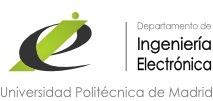A modular data acquisition system for high resolution clinical PET scanners
En las últimas dos décadas, la Tomografía por Emisión de Positrones (PET) ha demostrado ser una modalidad clave para el estudio de la biología del cúncer y trastornos cardíacos, y para la realizaciún imágenes moleculares, una tecnica que permite la terapia individualizada de la enfermedad [Weissleder01]. La mejor característica de la PET es su sensibilidad: es la tecnica que proporciona imúagenes moleculares con la mayor sensibilidad, y las imúagenes de cuerpo entero que produce no pueden ser igualadas por otras modalidades [Hoh97, Chae07]. Por otra parte, la PET no proporciona referencias anatómicas, lo cual es un problema facilmente resoluble a traves de su integraciún o coregistro con la tomografía computarizada de rayos X (CT) [Lu07]. Ademas, en com- paraciún con otras modalidades de imagen, la PET se caracteriza por bajas estadísticas de conteo (es decir, desintegraciones por unidad de tiempo), lo cual generalmente limita la resoluciún de la imagen. Sin embargo, detectores con geometrías dedicadas permiten solventar ester problema, y producir exce¬lentes resultados [Humm03]. Dos ejemplos destacables de especializacion, que tomaremos como aplicaciones de referencia, son la Mamografía por Emision de Positrones (PEM) y la monitorizacion en línea de dosis en hadroterapia (in-beam PET o, brevemente, ibPET). Las amplias posibilidades de especializacion tienen, sin embargo, una con¬trapartida: es necesario el desarrollo de sistemas de adquisicion igualmente especializados, cuyo coste y prestaciones puede impedir de hecho conseguir las ventajas teúricas proporcionadas por una geometría dedicada. El objetivo de esta tesis doctoral es proponer una nueva arquitectura tecnologica flexible, capaz de obtener prestaciones similares al estado del arte en distintas aplicaciones, a traves de una plataforma de adquisiciún compacta y eficiente en coste, adecuada para PEM e ibPET. En primer lugar, se exploraran el estado del arte y los problemas que han evitado la amplia difusion de equipos PET dedicados en entornos clínicos. Es¬pecial atenciún se dedicara a las soluciones tecnologicas y las características de los escaneres PEM anteriores. Se revisara tambien la situation de losequipos ibPET, especialmente las prestaciones requeridas para soportar efi¬cazmente la planificación de tratamiento en hadroterapia. En segundo lugar, se tratara un diseño conceptual propuesto como solucion al problema. Se propondrán y justificaran diferentes alternativas, con el fin de maximizar la eficiencia de detection y minimizar el coste. A traves de una serie de prototipos intermedios, se implementaran y caracterizarán las opciones de disenño elegidas. Por ultimo, se propondráa el disenño e implementacioán de un prototipo final de sistema de adquisicioán. El equipo en cuestiáon integraráa y extenderaá la soluciones validadas con los prototipos anteriores. x La investigation llevada a cabo durante esta tesis ha permitido realizar un sistema de adquisicion, con prestaciones al estado del arte, apto para el uso de PET dedicado en el entorno clínico del paciente, y que apoyara la investigation en PEM e ibPET. Summary In the last two decades, Positron Emission Tomography (PET) showed to be a key modality to interrogate biology for cancer and cardiac disorders, and to perform molecular imaging, a technology that permits individualized therapy of disease [Weissleder01]. PET's best characteristic is sensitivity: it is the most sensitive tech¬nique for medical molecular imaging, and the whole-body images it produces are unequalled by any other modality [Hoh97, Chae07]. Of course, it lacks anatomical reference, but this is a problem that can be easily overcome with X-ray (CT) (Computed Tomography) integration or coregistration [Lu07]. Moreover, even if PET uses relatively low statistics with respect to other modalities, which generally limits image resolution, it can produce excellent results by using dedicated detector geometries [Humm03]. Two remarkable examples for this kind of system specialization, that we will take as refer¬ence applications, are Positron Emission Mammography (PEM) and in-beam PET (ibPET) for dose delivery monitoring in hadrontherapy. However, the wide range of design possibilities has a counter effect: it re¬quires the development of specifically tailored acquisition systems, whose cost and performances could actually prevent the achievement of the theoretical advantages obtainable with a specialized detector assembly. This doctoral thesis aims at proposing an alternative technological archi¬tecture, able to achieve state of the art PET imaging performances by means of a compact, cost efficient acquisition platform, suitable for its adoption in both PEM and ibPET. Firstly, the state of the art and the controversies that prevent the broad use of dedicated PET in clinics will be explored. Special attention will be paid to the technological solutions and characteristics of previous PEM scanners. It will be also reviewed the current status of ibPET, with particular focus on the performances required to effectively support treatment planning in hadrontherapy. Secondly, a conceptual design solution will be discussed. Various alter-natives will be proposed and justified, with the aim of maximizing detection efficiency and minimize system cost. Through a series of intermediate pro¬totypes the various design choices are implemented and characterized. Thirdly, a final prototype of the acquisition system is designed and im¬plemented. This piece of hardware integrates and extends the solutions that have been validated through the previous systems. The research carried out during this thesis has allowed realizing a state of the art acquisition system that is suitable for specialized PET imaging in the clinical environment of the patient, and that will be used for further research in PEM and ibPET imaging.
- Inicie sesión para enviar comentarios
 Versión para impresión
Versión para impresión

